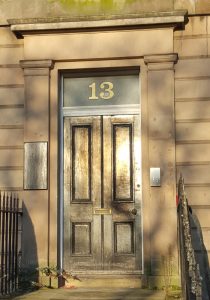Why Important
Maintaining the character of the period building very important for the unity of street in a conservation area and on listed buildings. The most understandably visible and often the simplest renovation is using the appropriate number font at the front of the period property.
Even though a commercial business may change, to ensure unity of the street scene, the door numeral style should not.
What to look for
Brass plates were superseded by cast brass numerals, and could use Roman characters (e.g IXV) or Arabic (e.g 95).
Painted numerals were probably standard on basement and some common stair doors. Sometimes the numeral was painted on stonework above or adjacent to the door and formed part of a painted panel, for example circular or shield-shaped with a shaded border.
Fanlight Numerals
 Numerals painted on fanlights are a later introduction during the Georgian period (after increased postal use in 1857). The age of the building or it’s style, is likely to suggest the appropriate style of number character to be used.
Numerals painted on fanlights are a later introduction during the Georgian period (after increased postal use in 1857). The age of the building or it’s style, is likely to suggest the appropriate style of number character to be used.
Also check the style used on surrounding period buildings to provide a guide to an appropriate number font design.
How to fix
Some numerals are carved into brass or stone and then painted. Although the original material may have been wax, when restoring, filling with paint is preferable because wax crazes in the sun.
Numerals, backplates and other items of door furniture should be secured to doors by a threaded rod welded to the back of the plate and held in place by a nut and washer sunk below the inner face of the door so that the method of fixing is invisible, or secret.
Numerals, as with all door furniture, should be left on when painting a door, and the paint taken up over the sides leaving the front face exposed for polishing. The protects the underlying wood from the ingress of water.
 Keeping to the same font for fanlight numerals is very important for the unity of street; conservation area and on listed buildings.
Keeping to the same font for fanlight numerals is very important for the unity of street; conservation area and on listed buildings.
Positioning is also critical, therefore, the services of a professional signwriter are best sought for this delicate and detailed work.
Avoiding creating problems
Do not use plastic or stick-on numerals, as they are inappropriate.
Historical background
The earliest numerals are likely to have been small brass plates on which Roman or Arabic characters were engraved and filled with black wax. Fanlight numerals are generally later (1857), after the introduction of the Penny Post and increased need to standardise postal addresses to help locate addresses in terraces.
